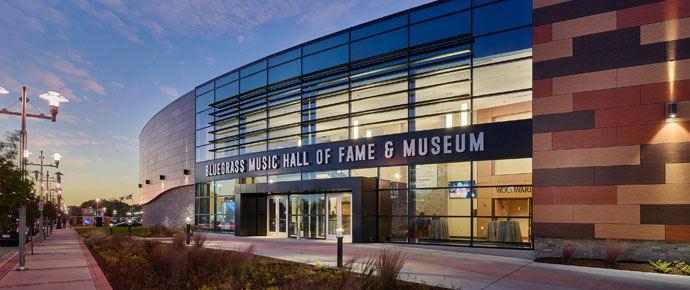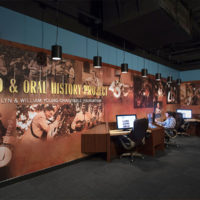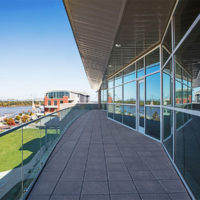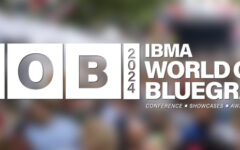
When I traveled to northwestern Kentucky earlier this month at attend the premiere of Big Family – The Story Of Bluegrass Music, I took advantage of a unique opportunity while I was there. The premiere was held in Owensboro, in the theater at the new Bluegrass Music Hall Of Fame & Museum, and a concatenation of events led to a private tour of the facility with Chris Joslin, the Executive Director.
The premiere took place on a Saturday evening, and Chris was unable to make it owing to a prior family commitment, but he had been urging me to visit the Hall since it opened last fall, and agreed to meet me on Sunday morning. As I needed to start back to Virginia myself, we met up at the Museum before they opened, giving us the time and freedom to see all the public exhibits, as well as get a look behind the scenes.
Chris was also able to share much of the back story on the items on display, plus how many of them were acquired. They still have some unused space inside the building, so keep an eye out for announcements to come on that.
The basic theme of the Museum is similar to that of the Big Family documentary – to tell the story of blugrass music from the very beginning through today, but using a mix of images, artifacts, and interactive exhibits to relay the history. When you enter the Hall, you find yourself in an impressive, glass-fronted lobby that encompasses the building’s three floors. From this lobby you have the option to go into the Woodward Theater, named for the Museum’s chief benefactor and founder, Terry Woodward, enter the well-stocked gift shop, or start your tour of the Museum.
The Theater is quite well-equipped, and can seat about 400 people for a concert. Professional lighting and audio have been installed, and video cameras are in place to allow for live recording. A live sound mixing board is in place at the back of the room, and there are full-featured video and audio recording rooms on the second floor for post-production mixing and editing. Joslin said that they haven’t really started promoting the fact, but this set up is certainly among the nicest facilities for live concert recording in bluegrass. The front of house has a great sound as well, and the deep stage would be suitable for small theatrical productions as well.
In the gift shop, where you also pay for admission or join as a member, there are all sorts of bluegrass-related items for sale, including t-shirts, CDs, hats, and other articles of clothing. Many of these can also be purchased from their online store.
Once you enter the museum proper, you are guided along a path that demonstrates the invention and development of the music over the years. It stars with the string band and mountain folk styles that preceded the bluegrass revolution, including a detailed exhibit on The Monroe Brothers. There is a great deal of information on what is now commonly called the Original Bluegrass Band, which was Bill Monroe, Lester Flatt, Earl Scruggs, Chubby Wise, and Cedric Rainwater (Howard Watts). Photos and instruments, plus explanatary posters, continue the storyline with exhibits on other early pioneers like Jim & Jesse, The Stanley Brothers, and eventually, Flatt & Scruggs.
Several rooms are adorned with a photo mural consisting of several individual images. The way they are mounted allows the staff to rotate the photos within the larger mural, or add new ones as they may become available. Some of the most fun was examining personal artifacts from icons like Bill Monroe, Jimmy Martin, and others, including instruments and suits of clothes.
And then there is the Hall of Fame room, with large bronze likenesses of each bluegrass hero who has been inducted into the Bluegrass Hall of Fame. The walls have room for many more plaques, but at some point Joslin admitted that they will need to examine other options. It is more than a little awe-inspiring to be in the midst of these trailblazers, even if only their likenesses.
If you are a serious student of bluegrass history – or as Chris put it, a bluegrass nerd – you may not learn much in these exhibits, but it is still exciting to see it all laid out so attractively, with the sort of dramatic lighting you see in a contemporary museum.
One station on the second floor was particularly enticing, a desk with multiple computers and headphones where visitors could watch the many interviews in the Museum’s Video Oral History Project. These are free-ranging discussions with the people who created bluegrass music, professionally captured on video, and preserved forever in the Hall of Fame. Working with the Nunn Center at the University of Kentucky, they have archived hours of conversations with such luminaries as J.D. Crowe, Mike Auldridge, Josh Graves, Carlton Haney, George Shuffler, Ralph Stanley, Bill Keith, Lance Leroy, Jimmy Martin, Larry Sparks, Bobby and Sonny Osborne, Mac Wiseman, Gloria Belle, Tex Logan, Ramona Jones, Wade Mainer, Donna and Patsy Stoneman, and many others. These stations are available any time the Museum is open, and I can imagine spending days there listening and watching these life stories told by the people who lived them. If I didn’t have a long drive ahead of me, I would have gotten started on them that day.
Those who followed the pre-construction fundraising for the Hall of Fame will recall an initial plan to include a fine dining restaurant in the building, but Chris told me that as they got into the final building phase, the Museum Board decided to set aside that space for event rentals instead. Located on the third floor, the room offers full length window views of the Ohio River, a complete catering kitchen, and other amenities, and it has become the place in Owensboro to host meetings, receptions, and the like. Joslin says that it provides a needed revenue stream, without the headache of managing a restaurant on site.
My private tour concluded just as the venue was opening, at a room just off the lobby where visitors are invited to try out a sampling of professional grade instruments donated by major builders. Chris jumped into host mode, and roped a number of folks into jamming along with us on a couple of bluegrass standards. It makes for a very welcoming first impression to see a spirited jam as soon as you enter the building.
The Hall also maintains a regular schedule of live shows, both in the comfortable confines of the Woodward Theater indoors, and an outdoor stage along the building’s back wall where people sit in the grass and enjoy the music. They have a full bar inside for events, and their license allows them to sell alcohol at the outdoor stage as well.
Owensboro will never be a big city, but offers enough of the comforts that modern tourists expect, including a good many entertainment offerings for children. Chris says that they expect direct flight from Nashville starting later this year, maybe a brief trip to town to visit the Museum, or attend a special concert – a simple matter for music vacationers.
Of course, the Hall is supported by admission fees, memberships, and donations. If you support the idea of this organization, please consider joining or contributing. Full details are online.















